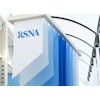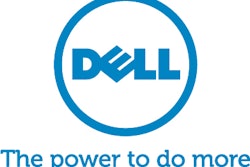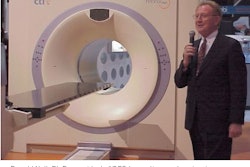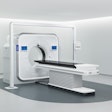CHICAGO - New developments in PET/CT imaging are a major focus in the RSNA booth of GE Medical Systems. The Waukesha, WI, company is highlighting a new hybrid scanner optimized for oncology imaging, and has added a 16-slice capability to its flagship PET/CT scanner.
Discovery ST is a new version of GE's Discovery hybrid PET/CT product line. The scanner is optimized for oncology imaging and treatment, featuring a bore that at 70 cm is 10 cm wider than GE's flagship Discovery LS system, and at 100 cm long is 30% shorter, according to Stephen Bolze, general manager of global functional and molecular imaging.
Discovery
ST also supports both 2-D and 3-D imaging with the large bore, an important
feature for oncology studies. The scanner is available in either a four-slice
or eight-slice CT configuration, with bismuth germanate (BGO) PET detectors.
Production shipments will start in the third quarter of 2003, with a list price
of between $1.9 million to $2.4 million depending on configuration.
GE's first hybrid PET/CT system, Discovery LS, will remain in the product line; indeed, GE showed a work-in-progress 16-slice version of the platform in its RSNA booth. GE plans to offer Discovery LS systems in four-, eight-, and 16-slice configurations.
Another PET highlight is ReadyLab, a turnkey FDG lab that can be installed more quickly than other systems, and relocated if necessary. GE is also demonstrating its commitment to preclinical molecular imaging by showing the Explore RS micro CT scanner that it acquired when it bought Enhanced Vision Systems earlier this year.
In MRI, GE's new Excite image-chain enhancement is taking center stage this week. First introduced in May, the company said it expects to have sold more than 1,000 systems globally by the end of 2003.
New enhancements are also being shown for other scanners in the GE product line, including diffusion-weighted echo-planar imaging for the Signa OpenSpeed scanner, while the Signa Ovation open scanner is getting new productivity features and a 72-inch flexible body coil.
GE's CT group is highlighting LightSpeed 16, the company's 16-slice scanner first introduced in June. Some 250 16-slice scanners will be installed by the end of the year, according to Peter Arduini, general manage for GE's global CT business.
Another new CT scanner is e-Speed, an electron beam tomography product released by the company's Imatron unit, which GE bought in 2001. Meanwhile, CT advanced lung analysis is a new software package designed to measure the volume of pulmonary nodules. The software can be used on any GE spiral CT scanner.
New dynamic digital x-ray system
Innova 4100 represents the expansion of GE's flat-panel digital x-ray technology into the fluoroscopy realm. The system has a 41 x 41-cm field of view, compared to the 21 x 21-cm field of view found on Innova 2000, GE's first dynamic flat-panel system for the cardiac market.
Unlike image intensifier tubes, the Innova panels don't see image quality degrade at the edges, giving users a larger effective field of view. The panels also have 10 times the dynamic range and deliver 20%-50% less radiation dose than conventional systems, according to Dow Wilson, general manager of global surgery, x-ray, and interventional imaging for GE.
FluoroCAT is a new surgical navigation workstation compatible with GE's installed base of OEC 9800 C-arms. The workstation supports surgical navigation for spine, knee, and ear, nose, and throat procedures, according to Wilson. GE is also touting its new relationship with Deus Technologies of Rockville, MD. The deal gives GE rights to distribute Deus' RapidScreen RS-2000 for CAD detection of analog x-ray images, and the companies agreed to develop a new version for use with GE's digital radiography products.
In mammography, GE is highlighting the success of its Senographe 2000D FFDM product, with 600 systems installed. The company expanded its range of CAD offerings by signing a deal with CADx Systems of Beavercreek, OH – GE will integrate CADx's Second Look software for use with Senographe 2000D.
In work-in-progress developments, GE is discussing ongoing work toward developing a tomography synthesis capability for Senographe 2000D. The technique involves the use of a rotating x-ray tube head that collects 11 images at 5º angles. The resulting data are synthesized into a single image that enables users to visualize a suspected lesion from multiple angles.
The technique is being investigated at Massachusetts General Hospital in Boston, and preliminary work there is finding that it could reduce callbacks by as much as 20%. A tomography synthesis option for Senographe 2000D is probably a couple years from market, according to Laura Bakosh, general manager of Americas women's healthcare sales and marketing.
New version of Centricity
GE is pointing PACS enthusiasts to version 2.0 of its Centricity integrated RIS/PACS offering. Centricity 2.0 includes new features designed for scalability, clinical advancements, and utilization of Web technology, GE said.
An integrated real-time 3-D capability has been incorporated, and the workstation software will also support large image data sets, such as eight and 16-slice CT studies, high-resolution MR exams, and cardiac images, GE said. Designed in collaboration with Stanford University, the user interface includes tools such as integrated maximum intensity projection/multiplanar reformatting (MIP/MPR), spine labeling, and color/grayscale mixed monitor support.
The Centricity architecture can also accommodate multiple patient identifiers, database replication for online data redundancy and disaster recovery, and network attached storage (NAS). Currently in clinical testing at three sites, Centricity 2.0 is targeted for release in the second quarter of 2003.
GE is also introducing Enterprise Archive, which provides a common storage and image distribution architecture to tie together multiple PACS networks across different sites regardless of the vendor, said Peter McClennen, general manager of global marketing at GE Medical Systems Information Technologies. Available now, Enterprise Archive can be integrated into an electronic medical record, allowing users to access images from across the enterprise using GE's Web browser application, he said.
Designed for small hospitals and standalone imaging centers, Centricity Express is a lower-cost, PC-based PACS offering. Running off a single Dell platform, Centricity Express can serve as a first step to a filmless environment, he said. Centricity Express will begin shipping in the second quarter of 2003.
GE is also touting what it calls its Centricity secure storage provider (SSP) service. SSP provides fiber connectivity over a wide area network to an offsite DICOM archive that can store both radiology and cardiology DICOM images, GE said. It will be available in the fourth quarter of this year.
As part of Centricity 2.0, the company has received U.S. Food and Drug Administration clearance to market soft-copy primary reading of digital mammography on a five-megapixel display. GE is also showing a voice-controlled mammography PACS module, which would include tools such as special hanging protocols and a QC package, McClennen said.
The mammography module will be part of Centricity 3.0, which is targeted for release at the end of 2003. Other enhancements planned for Centricity 3.0 include consolidation of cardiology and radiology image management, as well as IHE functionality, said David Henriksen, Americas marketing manager.
In ultrasound, GE pointed to the latest models in its Logiq line of scanners, including Logiq 5 and Logiq Book. Featuring the same scanning architecture as the Logiq 7 and 9 systems, Logiq 5 includes a touch-screen display and standard CRT display. It's targeted at obstetrics, vascular, small parts, abdominal, and cardiac applications.
A hand-carried system, Logiq Book includes full DICOM capabilities such as storage, printing, removable media, and worklist functions. It features an integrated 10.3-inch, high-resolution color monitor, a full-size keyboard, and an image archive that can store more than 4,000 images and cine loops. In addition, it has full cardiac, ob/gyn, vascular, gynecological, renal, urological, and real-time auto Doppler calculation packages with integrated reporting worksheets, according to the vendor.
A 3-D volume-rendering software package is also available as an option. Booth visitors can also check out the latest upgrades to GE's Logiq 7 and 9 series, including the firm's code technology. The firm's Voluson 730 Pro and Expert line of 3-D ultrasound systems are also on display.
GE is also debuting Logiqworks, a workstation that combines the firm's TruAccess raw data digital processing with GE's Centricity RA600 multimodality workstation, said Jeffery Peiffer, manager, Americas ultrasound marketing. Utilizing GE's TruAccess raw data processing tools, Logiqworks allows for reconstruction of images or modifying of settings at a workstation after the scan has been completed, he said.
Bone densitometry highlights include computer-assisted densitometry, which automatically identifies potential anomalies and offers solutions for correction, said Terri Bresenham, president and general manager of GE Medical Systems Lunar.
GE Lunar also discussed the benefits of employing GE's Revolution digital detector in bone densitometry analysis. A OneScan feature allows for acquisition of the ASP spine and both femoral measurements in one automated process, she said. An advanced hip assessment process includes new measurements, such as upper femoral neck and hip axis length.
GE Lunar also debuted Achilles InSight, a real-time ultrasound unit. A gel-free system, InSight allows users to verify heel position before acquisition, Bresenham said. In work-in-progress developments, GE Lunar discussed absolute fracture risk (AFR), which presents T-scores in a more consumer-friendly report and accounts for risk factors such as age, she said. A module called Dexter allows users access to analysis and reporting on a handheld PDA platform.
In the company's health services segment, GE is discussing its maintenance services, including a HIPAA-compliant broadband-based remote-service offering. In addition, a new asset management software works with the firm's IntelliMotion tracking software to allow customers to keep track of data such as equipment calibration records, said Paul Mirabella, president and CEO, of GE Medical Systems Americas & Healthcare Services.
GE is also highlighting its financial services, a range of financial options through which customers can pay for GE equipment. Performance Solutions is a service that helps customers optimize productivity, Mirabella said.
By Erik L. Ridley and Brian Casey
AuntMinnie.com staff writers
December 3, 2002
Copyright © 2002 AuntMinnie.com



















